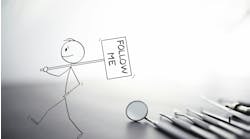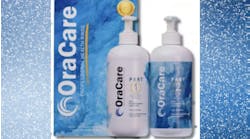Steven Pigliacelli, MDT, CDT
Converting to digital impressions can be scary. When you look at the marketplace, there are a lot of decisions to make, and there can be so many questions that it becomes overwhelming. Let’s take a deep breath, calm down, and look at the options.
Before committing to digital impressions, you should first ask yourself this question: Do you want to design and mill restorations in-house, or do you still want to partner with a laboratory?
If you’re thinking you want to bring things in-house, ask yourself this question: Are you prepared to set aside your time or your chairside assistant’s time to oversee the fabrication of indirect restorations?
In answering these questions, it’s important to realize that you’ll need to invest in additional equipment and training in order to bring work into your practice and maintain quality. But you don’t have to do it all at once. Personally, I recommend buying the intraoral scanner first. The learning curve can be six months. This way you can still work with a lab and focus your energy on mastering the scanning techniques and workflow.
Equipment
Next, let’s get familiar with the equipment, including what types of digital files different machines can generate and work with. Perhaps you’ve heard the term “STL,” which stands for “stereolithography.” It also refers to an “.stl” file format, which is similar to the “.doc” extension of a Microsoft Word file or the “.pdf” extension for an Adobe Acrobat file. STL is the most common file format used to record digital impression data. In essence, STL is the universal language that allows digital data transfer data between systems.
Although STL is the most common format for digital impression files, it’s not the only one. That’s an important point, because not every scanner file is compatible with every milling unit. Hence, you hear terms such as “closed architecture” and “open architecture.” Let’s go into these terms more in depth.
Closed versus open architecture
Closed architecture is where the scanner, software, and all peripheral machinery can work together—and only together—very much like how Mac computers worked for years. Back then, only Mac accessories were compatible with Mac computers. Similarly, digital impression systems using closed architecture integrate very well together, but not well or not at all with other manufacturers.
Systems such as CEREC (Dentsply Sirona) and NobelProcera (Nobel Biocare) are good examples of systems using closed architecture. CEREC is the pioneer of the intraoral scanner. The company’s engineers spent years upgrading and improving CEREC devices to get better scans. The integration of the scanner, software, and milling machines available for CEREC-authorized labs and CEREC dentists is seamless, simply because everything is designed and manufactured from a single source. In the case of NobelProcera, this is a lab scanner that sends the design file directly to Nobel Biocare’s manufacturing plant in Mahwah, New Jersey. This keeps everything on a consistent production and quality level.
Unlike closed systems, devices that use open architecture allow the scanner, computer, and other components to be bought separately—just like old component stereo systems from the 1970s. The benchtop scanners from 3Shape and Dental Wings that many labs have enable them to service open architecture devices. They allow the lab technician to scan a model and design any restoration that the software allows.
Open architecture allows you to buy a wax printer, milling machine, and other technologies that will work together with the same files.
To determine whether the technology you’re investigating is open or closed architecture, start by looking at the type of digital file that is created. As previously mentioned, the most common type is STL. With that in mind, here are a few more details about STL files that you should know: An STL file is a digital texture map of what is scanned. Just like a JPEG, which consists of millions of pixels, the digital STL consists of triangles. The smaller and denser the triangles, the more accurate the scan of the object.
It is also worth noting that in recent years, some closed architecture systems have become slightly open. Both CEREC and NobelProcera have opened up their software a bit to be more compatible with other technologies. In some cases, it is possible for non-STL files to be converted to STL files. For example, the CEREC system from Sirona has its own file extension, but can be converted to an STL file for uploading into a non-CEREC software so that a restoration can be produced.
Working with your lab
Before making a purchase, you’ll want to speak with your laboratory about your new investment. You should find out what types of mills and printers your lab is currently using and make sure you’ll have a smooth workflow. A typical workflow is:
1. The lab receives your STL file.
2. A restoration is designed on a computer.
3. The restoration is created in the milling machine.
4. The restoration is stained and glazed by a ceramist.
If the lab does not have the required machinery, there are numerous milling facilities throughout the world with whom your lab may partner.
Milling
Milling is one of the most common ways of producing a restoration. A material is literally milled down from a block into the desired shape. A chunk of titanium will become an abutment. A block of zirconia gets milled down to a crown. In most cases, dentists rarely send to milling centers. A milling center generally just creates one piece of a restoration, such as a milled custom abutment or even an implant framework. However, dental labs use milling centers because they do not have the capability of buying or housing the large equipment milling requires. Milling centers are usually owned and operated by larger commercial companies that have the capital to run a warehouse-size business with many large milling units that run all day to create custom products.
Lab technicians used to regularly buy a gold cylinder, wax to it, then invest, cast, and finish down to make a custom abutment. Today, technicians can scan, design, and then e-mail it to the mill. The milling center will read the scan, input it into a machine, and mill the abutment. The lab receives it a few days later ready for a crown to be constructed onto it, thus making it easier and more cost-effective for the lab. The number of products that can now be milled has grown quite a bit. For example, frames and bars made from metals such as titanium and cobalt chrome can be milled.
Zirconia is mostly milled in a lab and sometimes in a dentist’s office. The big difference between a lab’s and dentist’s milling unit is the material requirements. A block of zirconia is soft like a block of chalk. A milling bur can cut through it rapidly, and it lasts longer. Once a zirconia unit is milled, it needs to be sintered in an oven at a very high temperature. The unit shrinks a bit and becomes as hard as alloy. Now the unit can have porcelain applied, or in the case of monolithic zirconia, stain applied. This process is more attractive to labs since they can keep everything in-house. A dentist can do much of this in-house also; just a porcelain oven is needed for the porcelain application. The milling units for zirconia are called “dry mills.” This means the chalklike zirconia creates a lot of dust. A vacuum is required to run as long as the machine is working. The unit must also be cleaned out often.
Lithium disilicate is milled on these units, too. This material has become quite popular since it has a better translucency than zirconia. Lithium disilicate is a monolithic material that matches the shade as soon as it is crystalized in the oven. A simple stain and glaze technique is used by the ceramist or the dentist. This allows a crown to be inserted the same day as prepping. If sending to a lab, the technician can quite often make a model-free crown in less time than analog crown and bridge. The milling unit for lithium disilicate is done in a wet mill. The entire time the block is being milled, water is shooting onto it. This keeps it cool and prevents breakage. Upkeep is required to keep the unit clean and running.
Laser mills are now coming onto the scene. In theory, they should be less dusty and cumbersome, with no more wearing down of the milling burs.
Printing
Wax printers enable the printing of many materials, from wax for casting to acrylics for provisionals and surgical guides. As times goes on, more and more products will be available for printing procedures. Already there are larger centers that are printing metal frames. This will eliminate much of the waste with milling. Instead of taking a large block of titanium and milling a portion of it into a coping, only the precise final coping will be printed. After scanning in a dentist’s office, a provisional can be designed and printed immediately. Night guards, flippers, and full dentures are on the horizon. Eventually, both the lab and dentists will be able to print many dental prostheses.
The future
As with traditional analog crown and bridge, there are rules, protocols, and quality standards. The dentist and technician must be retrained on how to use the equipment. These machines are not magic wands. All the technology cannot replace a skilled practitioner. There are those who preach how dentists and labs will be replaced in a few years, but a lab scanner is the same as a wax spatula to the technician, and the intraoral scanner is just another tool for the dentist. If you look upon this technology as another necessary tool, you will realize how much it benefits your practice in efficiency and predictability.
As we have seen with the computer industry, cell phones, and electric cars, demand creates more options and better products. As the technology advances, we will be able to produce more varied prosthetics and use more tools. Digital is not the final innovation in dentistry. There are hydro scanning systems that perform like sonograms. New composites, polymers, pectin, lithium disilicate hybrids, zirconia, and more are being researched and beta tested now. It is conceivable that we may use stem cell technology to print teeth. The possibilities are endless, and it is the dentists who will be using this equipment. There is no replacement for trained professionals.
Steven Pigliacelli, MDT, CDT, is the owner and vice president of Marotta Dental Studio. He is a faculty instructor in postgraduate prosthodontics at the New York University College of Dentistry. Steven is the founder and president of the Association of Innovative Dentistry, an organization dedicated to supporting the next generation of dentists, specialists, and technicians.





